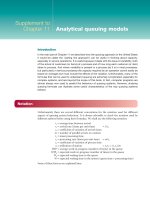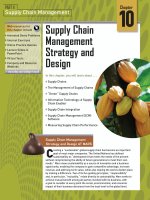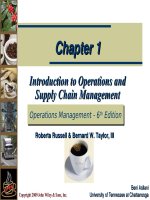Operation management 6e by russel and taylor ch08
Bạn đang xem bản rút gọn của tài liệu. Xem và tải ngay bản đầy đủ của tài liệu tại đây (735.41 KB, 31 trang )
Chapter 8
Human Resources
Operations
Operations Management
Management -- 66thth Edition
Edition
Roberta Russell & Bernard W. Taylor, III
Copyright 2009 John Wiley & Sons, Inc.
Beni Asllani
University of Tennessee at Chattanooga
Lecture Outline
Human Resources and Quality Management
Changing Nature of Human Resources
Management
Contemporary Trends in Human Resources
Management
Employee Compensation
Managing Diversity in Workplace
Job Design
Job Analysis
Learning Curves
Copyright 2009 John Wiley & Sons, Inc.
8-2
Human Resources and Quality
Management
Employees play important
role in quality management
Malcolm Baldrige National
Quality Award winners have a
pervasive human resource
focus
Employee training and
education are recognized as
necessary long-term
investments
Employees have power to
make decisions that will
improve quality and customer
service
Strategic goals for quality and
customer satisfaction require
teamwork and group
participation
Copyright 2009 John Wiley & Sons, Inc.
8-3
Changing Nature of Human
Resources Management
Scientific management
Breaking down jobs into
elemental activities and
simplifying job design
Jobs
Assembly-line
Comprise a set of tasks,
elements, and job motions
(basic physical
movements)
In a piece-rate wage
system, pay is based on
output
Production meshed with
principles of scientific
management
Advantages of task
specialization
High output, low costs,
and minimal training
Disadvantages of task
specialization
Copyright 2009 John Wiley & Sons, Inc.
Boredom, lack of
motivation, and physical
and mental fatigue
8-4
Employee Motivation
Motivation
Improving Motivation (cont.)
willingness to work hard because
that effort satisfies an employee
need
Improving Motivation
positive reinforcement and
feedback
effective organization and
discipline
fair treatment of people
satisfaction of employee needs
setting of work-related goals
Copyright 2009 John Wiley & Sons, Inc.
design of jobs to fit employee
work responsibility
empowerment
restructuring of jobs when
necessary
rewards based on company as
well as individual performance
achievement of company goals
8-5
Evolution of Theories of
Employee Motivation
Abraham Maslow’s
Pyramid of Human
Needs
Douglas McGregor’s
Theory X and Theory Y
•Theory X Employee
Selfactualization
Esteem
Social
Safety/Security
• Dislikes work
• Must be coerced
• Shirks responsibility
• Little ambition
• Security top motivator
•Theory Y Employee
• Work is natural
• Self-directed
• Controlled
• Accepts responsibility
• Makes good decisions
Physiological (financial)
Copyright 2009 John Wiley & Sons, Inc.
Frederick Herzberg’s
Hygiene/Motivation
Theories
•Hygiene Factors
• Company policies
• Supervision
• Working conditions
• Interpersonal relations
• Salary, status, security
•Motivation Factors
• Achievement
• Recognition
• Job interest
• Responsibility
• Growth
• Advancement
8-6
Contemporary Trends in
Human Resources Management
Job training
extensive and varied
two of Deming’s 14 points
refer to employee
education and training
Cross Training
Empowerment
Teams
an employee learns more
than one job
Job rotation
giving employees
authority to make
decisions
horizontal movement
between two or more jobs
according to a plan
Copyright 2009 John Wiley & Sons, Inc.
group of employees work
on problems in their
immediate work area
8-7
Contemporary Trends in Human
Resources Management (cont.)
Job enrichment
vertical enlargement
allows employees control
over their work
an employee is assigned a
complete unit of work with
defined start and end
Flexible time
nontraditional work location
Telecommuting
horizontal enlargement
Alternative workplace
employees work
electronically from a
location they choose
Temporary and part-time
employees
part of a daily work
schedule in which
employees can choose
time of arrival and
departure
Copyright 2009 John Wiley & Sons, Inc.
mostly in fast-food and
restaurant chains, retail
companies, package delivery
services, and financial firms
8-8
Employee Compensation
Types of pay
hourly wage
individual incentive or piece rate
employees are paid for the number of units they produce
during the workday
straight salary
the longer someone works, the more s/he is paid
common form of payment for management
commissions
usually applied to sales and salespeople
Copyright 2009 John Wiley & Sons, Inc.
8-9
Employee Compensation (cont.)
Gainsharing
an incentive plan joins employees
in a common effort to achieve
company goals in which they
share in the gains
Profit sharing
sets aside a portion of profits for
employees at year’s end
Copyright 2009 John Wiley & Sons, Inc.
8-10
Managing Diversity in
Workplace
Workforce has become more diverse
4 out of every 10 people entering workforce during
the decade from 1998 to 2008 will be members of
minority groups
In 2000 U.S. Census showed that some minorities,
primarily Hispanic and Asian, are becoming
majorities
Companies must develop a strategic approach
to managing diversity
Copyright 2009 John Wiley & Sons, Inc.
8-11
Affirmative Actions vs.
Managing Diversity
Affirmative action
Managing diversity
an outgrowth of laws and
regulations
government initiated and
mandated
contains goals and
timetables designed to
increase level of
participation by women
and minorities to attain
parity levels in a
company’s workforce
not directly concerned
with increasing company
success or increasing
profits
Copyright 2009 John Wiley & Sons, Inc.
process of creating a work
environment in which all
employees can contribute
to their full potential in
order to achieve a
company’s goals
voluntary in nature, not
mandated
seeks to improve internal
communications and
interpersonal
relationships, resolve
conflict, and increase
product quality,
productivity, and
efficiency
8-12
Diversity Management Programs
Education
Awareness
Communication
Fairness
Commitment
Copyright 2009 John Wiley & Sons, Inc.
8-13
Global Diversity Issues
Cultural, language, geography
significant barriers to managing a globally diverse workforce
E-mails, faxes, Internet, phones, air travel
make managing a global workforce possible but not
necessarily effective
How to deal with diversity?
identify critical cultural elements
learn informal rules of communication
use a third party who is better able to bridge cultural gap
become culturally aware and learn foreign language
teach employees cultural norm of organization
Copyright 2009 John Wiley & Sons, Inc.
8-14
Attributes of Good Job Design
An appropriate degree of
repetitiveness
An appropriate degree of
attention and mental
absorption
Some employee
responsibility for
decisions and discretion
Employee control over
their own job
Goals and achievement
feedback
A perceived contribution
to a useful product or
service
Opportunities for
personal relationships
and friendships
Some influence over the
way work is carried out
in groups
Use of skills
Copyright 2009 John Wiley & Sons, Inc.
8-15
Factors in Job Design
Task analysis
how tasks fit together to form a job
Worker analysis
determining worker capabilities and responsibilities for a
job
Environment analysis
physical characteristics and location of a job
Ergonomics
fitting task to person in a work environment
Technology and automation
broadened scope of job design
Copyright 2009 John Wiley & Sons, Inc.
8-16
Elements of Job Design
Copyright 2009 John Wiley & Sons, Inc.
8-17
Job Analysis
Method Analysis (work methods)
Study methods used in the work included in
the job to see how it should be done
Primary tools are a variety of charts that
illustrate in different ways how a job or work
process is done
Copyright 2009 John Wiley & Sons, Inc.
8-18
Process Flowchart Symbols
Operation:
An activity directly contributing to product or service
Transportation:
Moving the product or service from one location to another
Inspection:
Examining the product or service for completeness,
irregularities, or quality
Delay:
Process having to wait
Storage:
Store of the product or service
Copyright 2009 John Wiley & Sons, Inc.
8-19
Process Flowchart
Copyright 2009 John Wiley & Sons, Inc.
8-20
Job Photo-Id Cards
Time
(min)
–1
WorkerMachine
Chart
Operator
Date
Time
(min)
Photo Machine
2.6
Idle
–2
Key in customer data
on card
–3
Feed data card in
0.4
Accept card
–4
–5
10/14
Position customer for photo 1.0
Idle
Take picture
0.6
Begin photo process
Idle
3.4
Photo/card processed
Inspect card & trim edges
1.2
Idle
–6
–7
–8
–9
Copyright 2009 John Wiley & Sons, Inc.
8-21
Worker-Machine Chart: Summary
Summary
Operator Time
%
Photo Machine Time
%
Work
5.8
63
4.8
52
Idle
3.4
37
4.4
48
Total
9.2 min
100%
9.2 Min
100%
Copyright 2009 John Wiley & Sons, Inc.
8-22
Motion Study
Used to ensure efficiency of motion in
a job
Frank & Lillian Gilbreth
Find one “best way” to do task
Use videotape to study motions
Copyright 2009 John Wiley & Sons, Inc.
8-23
General Guidelines for
Motion Study
Efficient Use Of Human Body
Work
simplified, rhythmic and symmetric
Hand/arm motions
coordinated and simultaneous
Employ full extent of physical capabilities
Conserve energy
use machines, minimize distances, use momentum
Tasks
simple, minimal eye contact and muscular effort, no
unnecessary motions, delays or idleness
Copyright 2009 John Wiley & Sons, Inc.
8-24
General Guidelines for
Motion Study
Efficient Arrangement of Workplace
Tools, material, equipment - designated, easily
accessible location
Comfortable and healthy seating and work area
Efficient Use of Equipment
Equipment and mechanized tools enhance worker
abilities
Use foot-operated equipment to relieve hand/arm
stress
Construct and arrange equipment to fit worker use
Copyright 2009 John Wiley & Sons, Inc.
8-25









